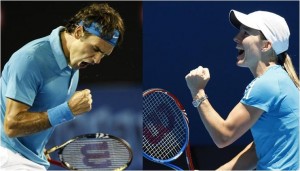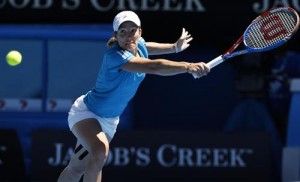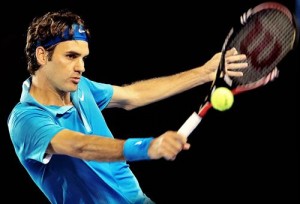Roger Federer and Justine Henin: Australian Reflection in Blue and White

Roger Federer and Justine Henin have been sporting similar colors and similar emotions during the Australian Open.
It was the first weekend of June 2009, and little more than a year after her dramatic retirement from tennis.
Justine Henin did not watch the women’s event at Roland Garros, for she had little interest in who would win the title she had refused to defend in 2008.
She did, though, watch the men’s tournament: “I feel closer to players like Roger Federer. And, of course, Roger was trying to win the only Grand Slam he had never won. Part of me wanted him to win but, in another way, I knew it would give me trouble mentally if he did.”
For like her male doppelganger, Henin had several times come within a whisker of winning the one Slam she was missing.
Her “trouble” was Wimbledon. If Federer—like her in so many ways—could scale his final mountain at the French Open, maybe she too could scale hers at Wimbledon. After all, Federer was in his 28th year and, in 2010, she would be too.
“You know that little voice we all have in our heads…it was telling me Roger winning the French was very special…it made me think how much I’d missed by not winning Wimbledon.”
That little voice bothered her so much that it made her pick up her racket. It then made her, three months later, announce her comeback to the Tour.
Had it been anyone but Federer, the impact on Henin may have been different. But when she looked in the mirror of her own career and saw Federer there, she was not simply recognising that both had their own tennis “betes noires”: She also recognised a male version of her own tennis, her own strengths, and her own character.

Justine Henin is looking to prove that she is all the way back following her return from retirement.
Both had come to embody the grace and fluidity of the all-court game. Both had intense concentration and fighting spirit. Both used skill, accuracy, intelligence, and speed to dominate bigger, often stronger, and frequently younger opponents.
Their similarities, though, begin before tennis enters the equation. Their veneers of unsmiling, channelled concentration on court hide charming and urbane personalities that find easy expression, whether in English or their native tongue.
Both are from small European countries made up of diverse nationalities. Henin’s Belgium straddles the cultural groups of Dutch-speaking Flanders and French-speaking Wallonia.
Federer’s Switzerland brings together the cultures and languages of France, Germany, and Italy.
Little wonder that these players seem at ease and at home everywhere.
Once the Australian Open began, it seemed as though Federer had decided to make the perfect gesture to the woman who spoke so freely of his inspiration.
On opening day, Henin walked onto court in sky blue and pristine white: the colors of a glacier, cool as ice, neat and crisp. White cap in place, white feet shimmering across the swimming-pool blue, no need of a sweat band nor a towel.
On day two, Federer strode onto court in identical hues: his classic cut polo in soft blue, shorts in sharp white, feet sparkling like snow in sunshine. His head, too, sported white, alternated with blue. He required just the one sweat: the coolest man in Melbourne.

Federer is looking to add another Grand Slam to his record total.
Had they the same sponsors, one might even suspect it was pre-planned. They had, after all, shared a practice court and some conversation before the tournament began. It was, instead, a happy mirroring of two intertwined players.
To watch them play tennis reveals immediately the real reason they are so often compared, and the reason they are always admired. It reveals, too, why this man and this woman always arrive on Melbourne’s courts to standing ovations and leave in the same way.
It begins with the physiques: perfectly proportioned, lithe, compact, and slim. Though less tall than many of today’s power players, both Henin and Federer have the mobility and speed to expose any inferior movement in their opponents.
Both have the strong legs to help them bend deep for spot-on timing, help them sprint to pick up net shots, help them keep their feet constantly on the move.
Look, then, at their forehands, and especially the classic top spin whip that wraps the right arm around the body. They can also apply so much roll across the ball with their Wilsons that their angled cross-court strokes can thread like a needle between net and approaching player.
Their backhands are a rare delight: A single-hander. It is a shot that captures in each player the outline of a dancer, whether air-bound in a jette or counterbalanced in an arabesque.
Both Federer and Henin make the most of the variety and subtlety that this elegant shot offers, whether they use skimming slice to defend or whipping slice to attack.
Driven with top spin, they use it to pierce an opponent’s defence like an arrow down the line, or flick it to the far corner and away from the court.
This backhand comes into its own on the volley, allowing their forward-moving bodies to align with, or away from, the net for a drive to either diagonal.
It offers touch off the feet and from below the net, where both Federer and Henin can adjust the racket head for pin-point accuracy.
Even on serve, where their actions are very different, Federer and Henin have more punch than their appearances suggest.
Many of Henin’s new young opponents are bigger and stronger than she is, and she spent much of the preparation for her return to the Tour on her serve. That Henin determination to come back even better than when she retired has born fruit.
In her match against fellow Belgian Yanina Wickmayer, for example, she produced a top speed of 113 m.p.h. and an average speed of almost 104 m.p.h. Both stats were higher than those of the 6’0″ Wickmayer: Henin is under 5’ 6”.
The Federer serve needs little introduction. He may not top the speed records, but he can still out-ace the biggest of servers: Andy Roddick in the 2009 Wimbledon final is a prime example. And at the Open, Federer sits in third place for percentage of points won on his first serve.
He, like Henin, is not the tallest and not the strongest. But he has great disguise, great variety of spin and placement, and textbook motion and timing.
For all the technical and physical similarities between Henin and Federer, they have one additional quality in common: Tennis vision.
It is their ability to play the shot, the game, and the match that most penetrates their opponents.
It is the ability to use the serve and volley against a rhythm player, a drop shot and lob against a big player, and a defensive slice or flat passing shot against a net rusher.
It is the desire to keep adding new shots that counter new opponents and new game-plans.
It is the self-belief to switch from defence to offence, to step inside the baseline, and take control.
Martina Navratilova—one of the game’s greatest attackers—admired the Henin offensive game more than anything else. “Her offence is just phenomenal…it’s sort of like we’ve got ‘the female Federer,’ or maybe the guys have ‘the male Justine Henin.’”
Little wonder that Henin looked at Federer last June and thought, “If he can do it, so can I.”
And little wonder if Federer should cast a beady eye towards his mirror image in the women’s competition at Wimbledon this year.
But before Henin tries to claim her career Grand Slam in London, she has the small matter of the present Slam to address. No doubt Federer is keeping tabs on that, too.










